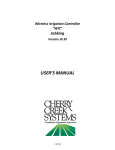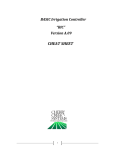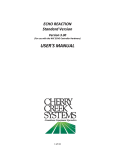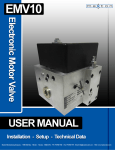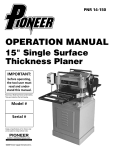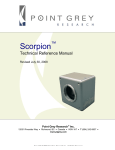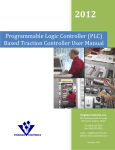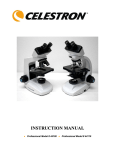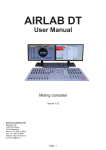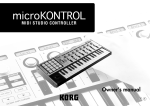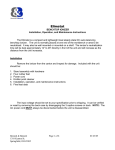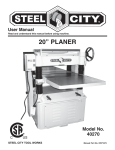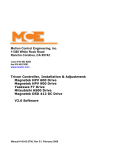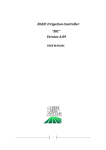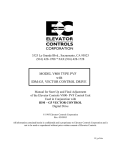Download USER`S MANUAL - Cherry Creek Systems
Transcript
COMPASS CAPTURE with AREA CAPTURE & STEP,STOP,WATER Version 3.30 (For use with WIC BOOM Controller Hardware) USER’S MANUAL 1 of 68 Table of Contents Description Page Updates & New Features for WIC 3.30 ............................................................................... 5 Key Concepts ....................................................................................................................... 7 Terms & Definitions: ........................................................................................................... 9 External Switch Definitions ............................................................................................... 10 Diagnostics ........................................................................................................................ 14 Keypad test .................................................................................................................... 14 Markers (Calibration Check-Points) .............................................................................. 15 Input Switches (Sensors) ............................................................................................... 15 Solenoids ....................................................................................................................... 16 Motor & Motion Tests................................................................................................... 17 Position Encoder ........................................................................................................... 18 Set-Up ............................................................................................................................... 19 System Set-Up ............................................................................................................... 20 Boom Name (for use with Wireless Accumulator) ................................................... 20 Date / Clock (used for Time-Based Auto Start)......................................................... 20 Network Mask (for use with Wireless Accumulator)................................................ 21 Pass-code .................................................................................................................. 21 Initialization............................................................................................................... 22 Motor Set-Up................................................................................................................. 24 Acceleration .............................................................................................................. 25 Deceleration .............................................................................................................. 26 Drive Settings ............................................................................................................ 28 Timeout (Motion Error timing) ................................................................................. 30 Motor Reversing ....................................................................................................... 30 Encoder Reversing .................................................................................................... 31 Boom Settings ............................................................................................................... 33 Bay Length................................................................................................................. 33 Set Position ............................................................................................................... 35 Parking Location........................................................................................................ 36 Go-To Speed .............................................................................................................. 37 Row Configuration .................................................................................................... 38 2 of 68 Bay Calibration .......................................................................................................... 40 Operations (Crop Settings)................................................................................................ 43 Passes & Watering......................................................................................................... 43 Auto Scheduling (Time Zones)....................................................................................... 46 Areas (Distances) ........................................................................................................... 47 Area Capture Mode ....................................................................................................... 48 Manual Operations Screen: .............................................................................................. 50 Manual Run Mode......................................................................................................... 50 Walk and Water............................................................................................................. 52 Quick Water................................................................................................................... 53 Park Boom ..................................................................................................................... 53 Area Viewer ................................................................................................................... 54 Manual List Mode.......................................................................................................... 54 Auto Run (Time Based) ..................................................................................................... 55 Step / Stop / Water ........................................................................................................... 56 Troubleshooting and Support ........................................................................................... 58 Wiring Diagrams & Layouts: ............................................................................................. 60 Options and Upgrades ...................................................................................................... 62 Appendix A – FAQ’s ........................................................................................................... 63 Rows/Solenoids Setup ................................................................................................... 63 Deceleration Example ................................................................................................... 66 Auto Mode Interval Clarification ................................................................................... 68 3 of 68 Cherry Creek Systems 2675 Akers Drive Colorado Springs, CO 80922 Toll Free 877-558-3246 877 www.cherrycreeksystems.com Dear Customer: We would like to thank you for taking a bold step in greenhouse irrigation by purchasing our “Compass Capture” program! Although it might appear to be very complex, complex the greatest possible care went into making this program as user friendly as possible while keeping all thee functionality that you have come to expect. There have been many chan changes to the new program for our WIC Compass Capture Controller. ontroller. We believe that once you become familiar with all that this new program has to offer, you will be extremely pleased with how easily manageable irrigating your crops has become. We would welcome and encourage you to make suggestions as to how we can improve this User’s Manual. anual. It is our intent to provide you with the highest quality equipment equip and state-of-the-art art watering systems, as well as first rate tech technical al follow up support. If this is the 1st time setting up the Boom, please follow this order in working through the manual: 1. Key Concepts 2. Diagnostics 3. Setup Again, thank you for your business and we look forward to assisting you in any way we can. Feel eel free to give us a call, or contact us via email (see above). Sincerely, Cherry Creek Systems Team 4 of 68 Updates & New Features for WIC 3.30 Wireless Irrigation Controller – 3.30 “Area Capture” The controller’s simple menu structure makes initial setup and operation easy to master. Passcode protection prevents unauthorized or accidental changing of the systems critical settings. One button start makes operation easy for untrained personnel. Remote start capability allows interface to greenhouse environmental control systems. Scheduling enables a grower to repeat specific watering runs on an interval basis and repeat daily without user intervention. A variety of manual watering modes allow the grower flexibility to water a crop as needed. The controller’s reliable encoder positioning system makes the Step, Stop, and Water mode very accurate. This allows the Boom to move (step) to a specific location, stop and water for the programmed time, and then step to the next location and so on down the length of the bay. The Walk and Water mode is useful for spot watering of a crop. The user can turn solenoids on or off while passing over the crop and control the speed of the boom. The Quick Water mode lets the user set up a one-time run over a specific area. Up to sixteen crops can be defined for a bay, and sixteen specific areas can be set for each crop enabling the user to grow many different crops in a single bay. Some of the specific details of the programs features are described below: AREAS vs. JOBS: One of our best features of this new program is the change in the architecture. Instead of using Jobs: magnets that constantly need to be moved and readjusted when a crop moves or gets replaced by another crop. We now utilize Areas: user programmed distance/measurement, allowing greater control over the various crops in a Bay. SMART BOOM MOVEMENT: The Boom only moves to the areas that need to be watered & parks where it is programmed. It no longer has to go from one end of the bay to another (Home to Away, then back to Home) every time it makes one pass and doesn’t have to rest at the “Home” position. This reduces wear and tear on the Boom and its moving parts, saving time and money. STEP/STOP/WATER: One feature that sets this controller apart from the competition is the Step, Stop & Water function. It has the ability to move the Boom to a user defined distance, then stop & water for a programmed amount of time, then move on to the next distance and continue. For example, you can set-up large 12” pots in a checker-board pattern @ 18” centers, have the Boom start at the first row of pots in the irrigation “Area”, then water every row of pots down the Bay in this same pattern. WALK & WATER: We have added the possibility to walk beside your Boom and water your crops by the press of a button (optional remote hand-held controller). You can simply walk the Boom to the Area that needs to be watered and turn on and off the solenoid(s). MULTIPLE TIME PERIODS (ZONES) FOR CROPS: You now have the option of assigning each crop up to six (6) time periods or “Zones” for irrigation. For example, you can have Crop #1 water from 7:00 – 10:00 then again at 13:00 – 15:00 without reprogramming every time. MULTIPLE REMOTE CROP ACTIVATION VIA COMPUTER: It is now possible to irrigate individual Crop Numbers using inputs from ARGUS™, PRIVA™ or any other environmental controls. Each Crop # can be prompted to have a “Yes” or “No” status. If the Crop # is set to “Yes”, then the Boom will run the program as it is set in the controller, and run all Crop #’s set to “Yes” in sequential order. If the Crop # is set to “No”, then that Crop will not run and will be ignored. This allows for the user to set parameters in their environmental 5 of 68 controller to start a program based on conditions within the greenhouse. Similar to a VPD system, the user can set the Environmental Controller to water/mist to the crops under the boom using light, moisture (relative humidity), temperature, etc. giving the user more precise control. If the boom is running an Automatic (Timed) program, then the Remote Start program will go into the queue and will start after the current running Auto program is completed, then go back into Auto and wait for its next time activated run sequence. Please talk to your Cherry Creek representative for more details on our Wireless Network System. DUAL SIGNAL ALARM OUTPUT BOARD (ADDITIONAL COST): The WIC also has an dual “Alarm Out” function (a separate board that attaches to the Main WIC board), allowing the user to tie into the Environmental Controls “sense-phone” system that will alert the user to any alarms activated on the booms, and call out that a problem exists and also what type of error is present. The 2nd output can be tied to a light and/or audible alarm so that the error(s) can be seen visually in the greenhouse in any case the user is not set up to be prompted by the “sense-phone” command. WIRELESS KEY-FOB WALK SWITCH DEVICE (ADDITIONAL COST): There is also a handheld key-fob device available that can be tied into the Remote Start function. The device has 4 buttons and can be used. 2 of the buttons are used as a “walk switch” (move the boom home or away by jogging the motor). A 3rd button can be set as a “Remote Start” control, and the 4th button calls the Boom to its pre-set “Park Location”. 6 of 68 Key Concepts *** Read this First! *** Please follow this order when working through the manual and setting up your Boom for the first time time: 1. Key Concepts 2. Diagnostics 3. Setup Figure 1 Row: A run in the greenhouse; usually left or right of the center aisle. It can also be defined as the number of solenoid “groupings” that are in the bay. If there are 4 bench runs across the width of the bay, then each bench could be assigned its own row (1 mist & 1 water solenoid per row). In Figure 1 on the right, there are 2 rows with a walkway running down the middle. 1 Water & 1 Mist Spray bar(s) 1 Water & 1 Mist Spray bar(s) BOOM = 2 rows Solenoids 1 & 2 Solenoids 3 & 4 Area: An Area is a given distance within the bay (example: 0.00 Ft to 110.00 Ft) that needs to be watered or misted by the Boom. Areas are programmed by the user depending on o the needed requirements. See Figure 2 pg. 8 Crop: This allows the user to combine multiple “Areas” into one “Crop” to minimize information input. In the example xample (fig. 2), Areas 1 and 6 would be considered a “Crop”. See Figure 2 pg. 8 Time Zone: This is a given period of time. e. The WIC uses a 24 hour format (military time): time) 1:00 PM = 13:00 12:00 AM = 00:00 10:00 AM = 10:00 10:00 PM = 22:00 7 of 68 Keypad: 0 thru 9 = Data Entry E = Enter / Save & Exit A = Advance Screen / Run Crop B = Cursor Up / Increase Speed C = Cursor Forward / Left D = Cursor Back / Right F = Cursor Down / Decrease Speed 0 = No / Disable 1 = Yes / Enable Set Up and Cropping: Basically, there are 4 steps: 1. 2. 3. 4. Set up the number of rows needed Set up areas in each row Assign areas to a specific crop number Set the crops with user-defined instructions Figure 2 Area 6 = Crop 1 (areas 3 and 5) Area 3 = Crop 2 (areas 2 and 4) Area 5 = Crop 3 (areas 1 and 6) Area 2 Area 4 Area 1 Let’s say you have 3 Crops, as laid out in the greenhouse above. Even though Crop 1 is in 2 different areas, you don’t have to input 2 different programs. You simply give Crop 1 watering instructions, and both programmed areas under Crop 1 will receive the same watering regimens. 8 of 68 Terms & Definitions: Acceleration: Speed setting that controls how the Boom will initiate or “take off” when starting a programmed irrigation cycle, as well as when the Boom turns around to initiate another pass. Area: The programmed distance(s) that the Boom will execute the needed task. Area Capture: Function allows the user to walk alongside the Boom using the keypad to toggle the controller to “Capture” the starts/ends to the Areas under the Boom. Area Viewer: A list showing the Crops and their Rows & Areas for reference. Auto Run: The state the Boom is in when Auto Schedules are being executed. Auto Schedule: Uses Time Zones to start the appropriately programmed Crops. Bay Calibration: The Boom needs to be calibrated to the length of the Bay in order for the Boom to use distances to travel. * See Bay Calibration section * Crop: This is a Group of Areas that will have the same water/spray treatment. Deceleration: The setting that will allow the Boom to slow down as it approaches the ends of the bay or the programmed stop/turn-around point. FPM: Feet-Per-Minute; the speed that the Boom uses as a reference. Go-To Speed: Speed that the Boom will travel to its programmed destination. Interval: Amount of time that the Boom waits in between Passes when using Auto Schedules & Time Zones to initiate Crops. Markers: “Checkpoints” in the bay that will help to maintain the Boom’s Calibration (the Crop Area Viewer allows the user to see the number of Markers & their distance). * This can be a Limit Switch or Magnet Reader * Manual Run: After Crops have been assigned the necessary Areas, the user can run the Crops manually by using this menu. There are 2 ways to use Manual Run: one Crop at a time or by using the Manual List feature. Manual List: Allowing the user to program a List of Manual Crops that need to run. The List will run in sequential order from Crop 1 thru 16. Parking Location: The Boom can be set to Park at any location within the bay; parking after the programs are finished, or the user presses Park. Passes & Watering: The screen where the Crop functions are programmed. Quick Water: Allows for a single Area to be programmed to water/spray. Remote Start Function: Each Crop can be programmed to start using an external signal source, such as an Environmental Control System, allowing the system to initiate the Boom to execute the enabled Crops. Row Configuration: Defined as “Rows”, this function will allow a Solenoid or series of Solenoids to be assigned to an Area. SSW: Step / Stop / Water (described in Updates & Features section) Start from Home: Developed for the propagation grower. The Boom will Start from Home on every Pass programmed to run in that Crop. This allows the user full control over the amount of water/spray that the cuttings or plugs in that Crop are receiving. This works well when using the Automatic Start feature to water/spray at different Time Intervals. Time Zones: The programmed times that Auto Schedules will start and stop. Walk & Water: Allows user to Walk with Boom and turn on and off solenoid valves at needed distances and Water/spray without having to program a “Crop”. Water Time (step/stop/water): The amount of time that the Boom will stop & water (activate solenoids) when using the Step/Stop/Water feature. This time is in seconds, allowing the user to enter down to a tenth (0.1) of a second. Wireless Networking Function: Allows the WIC to be controlled by a Network Accumulator via any available WIFI signal. * Ask a CCS team member for more details * 9 of 68 External Switch Definitions • SW1 –Marker Whisker limit (or magnetic) sense switch (mandatory). Used to save the position in which the Bay Markers are detected. The stored position will define a “checkpoint” for the controller to keep its position accurate if it ever gets lost between Markers. • SW2 – Home magnetic sense switch (mandatory). The Boom will stop at the programmed distance after the Home point sensor detects a magnet. This keeps the calibration of the Home position. • SW3 – Away magnetic sense switch (mandatory). The Boom will stop at the programmed distance after the Away point sensor detects a magnet. This keeps the calibration of the Away position. • SW4 – Park Switch This switch can be used in order to Park the BOOM at the parking location as set in the Setup->Boom Settings->Boom Setup->Parking Menu item. Please note that even if this item is set to OFF after running a crop, the switch will still make the BOOM Park at whatever destination was previously set. • SW5 - Collision Switch. This switch input must be closed at all times to allow the Boom to run. The inputs may be connected to an object detection (IR Sensor) or Collision Switch that will open the normally closed circuit when an object is detected in the path of the Boom. A simple jumper wire between the SW5 & GND terminal connections may be used to keep the switch permanently closed which will allow the Boom to run. • SW6 – Remote Auto Start Switch. Used in conjunction with a 24VAC to dry contact relay to start the Boom “Remotely” via an Environmental Control System (Priva, Argus, Wadsworth, etc.) • SW7 – Remote Home Switch. Used to move the Boom in the Home direction with a Boom Walk Switch. The remote away switch (SW8) is required to operate the Boom in the remote mode. Refer to SW8 description for the operation and function of SW7. • SW8 - Remote Away Switch. Used to move the Boom in the Away direction with a Boom Walk Switch. The Boom can be moved using the remote home and away switch option. When the Boom is stopped/idle, pressing the switch in either direction will start the Boom moving at 10 Feet Per Minute (FPM) in the respective direction. Pressing the switch in this direction again will increase the speed by 10FPM. If the switch is pressed repetitively, the speed may be increased up to 150FPM. To slow down the Boom, press the switch in the other direction and the boom will slow down by 10FPM until it comes to a stop. • IN 1 / IN 2 / GND / +NRV - Proximity sensor. Used for the Boom’s Encoder to detect Speed, Distance and Motion. The sensors get their power from the 18V+ power that comes from +NRV (Non-Regulated Voltage). 10 of 68 WIC Parts List: 330-0001 – WIC Controller - Complete Assembly - w/ display, keypad & DC power supply; mounted in box w/ lid & screws 330-0006 – WIC DC Power Supply Board – Internal (Standard) - Used to power the motor that the WIC is controlling 330-0008 – WIC Main Board only w/out display - NO display, keypad, DC power supply or box/lid 330-0010 – WIC External DC Motor Control Board Assembly – Minarik - Mounted in Watertight Plastic Box w/ lid 330-0016 – WIC 4-20mA Interface Board - Necessary for use w/ Minarik External MCB 330-0017 – WIC Main Board w/ display - NO keypad, DC power supply or box/lid 330-0018 – WIC LCD Display Enhancer - Brightens the screen on the display if the screen has black blocks behind the characters/digits 330-0019 – WIC EZ Downloader Device - Allows the user to install upgrades on the WIC 330-0020 – WIC Keypad - Used to interface w/ the WIC 315-0006 – 4x20 LCD Display Assy - LCD Display Module 11 of 68 330-0031 – Alarm Output Board - Designed to send out a signal when the Boom goes into Error. Can be tied into an audible/visual alarm, or into an Environmental System (Sensi-Phone) so the user can be notified that the Boom has encountered a problem (ex: Motion Error) 510-0024 –Large Control Box Lid - Clear cover on Boom controller 330-0032 – WIC 24V AC Power Board - Used if customer needs to deliver 24VAC to the Controller 330-0030 –GS1/GS2 RS485 Communication Board - Used in order to connect controller to an AC VFD controller 12 of 68 Main Menu: *** To get to the Main Menu from almost any screen, press “E” repeatedly. *** BOOM NAME 02:16:01 WIC – 3.30 1= MANUAL 3= SETUP 2= AUTO 4= DIAGS 13 of 68 Diagnostics If it is the first time setting up the Boom, it is highly recommended that you go through the diagnostic menu, BEFORE YOU SET UP YOUR BOOM. This process will insure all of the inputs are functioning properly and that nothing was damaged during shipping. * The best way to get thru the Diagnostics process is to work backwards through the menu. Starting with the Keypad test, and ending with the Motor & Motion tests. * *** To get to the Main Menu from almost any screen, press “E” repeatedly. *** 1. From Main menu press 4 (DIAGS) Diagnostics Menu: DIAG MENU E = EXIT 1=MOTOR & MOTION 2=SWITCHES/SOLENOIDS 3=MARKERS 4=KEYPAD Quick Menu/ Keypad Number Reference Keypad test (Main Menu, Press 4, Press 4) In this menu you can press each key to check if all the keys are working. 1. From Main menu press 4 (DIAGS) 2. From the Diagnostics menu press 4 (KEYPAD): KEYPAD TEST E=EXIT KEY = 3. Press any keys on the keypad to see them displayed on the screen. 4. Press the “E” key repeatedly to return to Main menu. 14 of 68 ________________________________________________________ Markers (Calibration Check-Points) * Described in the Definitions section * (Main, 4, 3) *** Skip this menu until the Boom is Calibrated; numbers will automatically show up on the screen after Calibration. Use this screen for reference & diagnostics *** 1. From the Main menu press 4 2. From the Diagnostics menu press 3 (MARKERS): MARKER TABLE 1 (AWY) M01: ---.—FT M02: ---.—FT M03: ---.—FT 3. Press “C” to show the Away Marker Table; Press “D” to show the Home Marker Table. Press “B” or “F” to scroll between Marker numbers. After Calibration, both tables should contain the same number of Markers, even if they are different distances. 4. Press “E” to Exit and Save. ________________________________________________________ Input Switches (Sensors) (Main, 4, 2, 2) * In this menu, check to see if the Boom’s Magnet Readers and other switches are working properly. * 1. From the Main menu press 4 2. From the Diagnostics menu press 2 (SWITCHES/SOLENOIDS): 3. Press 2 for Input Switches SWITCH TEST SW E=EXIT 1 2 3 4 5 6 7 8 SW = 0 0 0 0 1 0 0 0 MARKER 000 003 Sensors / Switches 1 = Marker 2 = Home 3 = Away 4 = Park Boom (if Parking position set) 5 = Collision (optional; always on) 6 = Remote Start (Environmental Control) 7 = Go Home (Walk Switch) 8 = Go Away (Walk Switch) NOTE: Pressing keys 1-8 on the keypad will show that switch #’s intended purpose on the bottom line of the display. 15 of 68 4. Magnet Readers – You should have 2 magnet readers on your Boom. Home & Away. The Home Sensor will be on one side of the Boom (pointed at the rail) and the Away Sensor will be on the other side (also pointed at the rail). To check readers #2 & #3 wave a magnet in front of each one. You should see the display show a “1” under Switch #2 or “1” under Switch #3. 5. The “1” under Switch “5” will always appear, unless the Collision Sensor is used. When a “0” appears under the Switch # this indicates that the switch is either inactive or not functional. * For more information on the switch failures please reference the “Troubleshooting” page for more info * 6. Marker Whisker Limit Switch – There will be a “Whisker” Limit switch on one side of the Boom. This is used to save the position in which the Bay Markers are detected. The stored position will define a “checkpoint” for the controller to keep its position accurate if it ever gets lost between Markers. Clicking the “Whisker” on the Limit switch will show a number “1” under Switch #1 if it is functional. This switch is VERY important for the Calibration Process and must be functional. 7. Press the “E” key repeatedly to return to Main menu _______________________________________________________ Solenoids (Main, 4, 2, 1) 1. From the Main menu press 4 (DIAGS) 2. From the Diagnostics menu press 2 (SWITCHES/SOLENOIDS): 3. Press “1” to go to the Solenoid Test screen: SOLENOID TEST E=EXIT SOL 1 2 3 4 5 6 7 8 SOL = 1 0 0 0 1 0 0 0 SOL 1 = ROWS 01 4. Press the “1” through “8” keys to alternately turn on and off the respective solenoid valves; water should appear as the keys are pressed. 5. Press the “E” key repeatedly to return to Main menu. 16 of 68 ________________________________________________________ Motor & Motion Tests (Main, 4, 1) 1. From the Main menu press 4 (DIAGS) 2. From the Diagnostics menu press 1 (MOTOR & MOTION): MOTION TESTS E=EXIT 1 = BOOM GO TO TEST 2 = BASIC MTR 3 = PARK 4 = POSITION ENCODER ________________________________________________________ 1. Press “1” to go into BOOM GO-TO TEST ** The Boom Go-To test is a good way to check if the Boom is calibrated and accurate. When the Go-To Test is executed, the Boom will travel to the programmed distance and stop. ** BOOM GO TO TEST A = GO E = EXIT 000.0 FPM HOM 000F 00IN GOTO: 010.00 B/F = SPD 2. Program the distance that the Boom needs to “Go-To” and press A to Go. The Boom will travel to that distance and stop. 3. Press “E” to Exit back to the Motor & Motion menu. ________________________________________________________ 1. Press “2” to enter the BASIC MOTOR TEST. ** The Basic Motor Test (diagnostics) is a good way to check the Motor function. When the Basic Motor Test is executed, the Boom will travel in the programmed direction, at the programmed speed until the user either changes direction and speed or stops the Boom. ** MOTOR DIAG: 044.36FT PWR: 10.0% DIR: HOME C=+.5 D= -.5% EXIT=E B=+10 F= -10% DIR=A 2. 3. 4. 5. Press “A” to change direction. Press “B” to increase speed by 10.0% or “C” to increase speed by 0.5%. Press “F” to decrease speed by 10.0% or “D” to decrease speed by 0.5%. Press “E” to stop and Exit back to the Motor & Motion menu. 17 of 68 ________________________________________________________ 1. Press “3” to enter the BOOM PARK. 2. If a PARK location is set under “BOOM SETTINGS” then the Boom will park at the programmed distance and return the Main menu. THE BOOM IS PARKING AT 005.00 FEET 100.00FPM HOM 046F 07IN 0,E = EXIT 3. If a PARK function is not desired, press “E” to exit and return to the Motor & Motion menu. ________________________________________________________ Position Encoder 1. Press “4” to enter the POSITION ENCODER. ** The Position Encoder test (diagnostics) is a good way to check the Boom’s Encoder function. When the Position Encoder Test is executed, the Boom will travel in the programmed direction, at the programmed speed until the user either changes direction and speed or stops the Boom. ** *** Motion Errors and/or Sensor Inputs will NOT function in this menu. This is NOT a good way to move the Boom within of the Bay; this is ONLY to test the function of the Encoder and its Position (tic & error count). *** ENC DIAG: 093.10F PWR: 10.0% DIR=HOME 025.0FPM AWY TICS: 00265 ERRS: 0000 Note: The 4th line will flash back and forth between Tics & Errors and Keypad options 2. Press “A” to change direction. Then press “B” or “C” to increase speed and press “F” or “D” to decrease speed. 3. When running in the Boom in the Home direction, the bottom left “TICS” number should decrease, or go into a negative number. When the Boom is going in the Away direction, the TICS should increase. If this is NOT the case, then the Encoder must be reversed in “ENCODER REVERSING” menu under “MOTOR SETUP”. 4. Also when running the Boom under the “Encoder Position” menu, the bottom right of the screen may show “ERRS” (errors), which means that the Encoder is not counting Tics correctly. If this is the case, the Proximity Sensors need to be adjusted closer to the Encoder Cog. Please contact CCS to further understand the Encoder and its function. 5. Press “E” to Exit and return to the Main Menu. 18 of 68 Set-Up If you are setting up for the first time, please go through your diagnostics menu first, before proceeding with Setup. There are 4 items under the SET-UP menu. 1. Crop Settings 2. Boom Settings 3. System 4. Motor In this “Set-Up” section, we will start with the System Set-Up and work our way through the other sections as they apply. This is the easiest way to “Initialize” the WIC Controller. From the Main Menu press 3 for SETUP MENU SETUP MENU E=EXIT 1= CROP SETTINGS 2= BOOM SETTINGS 3= SYSTEM 4= MOTOR Press 3 for SYSTEM Settings, the Controller will prompt a Pass-code to be input by the user. The factory set default Pass-code is 0000 (four Zeros). *** To change the Pass-code, refer to the “Pass-code” section of the “System Set-Up” menu *** ENTER PASS CODE: E = EXIT **** SYSTEM SETUP E= EXIT 1= NAME 2= DATE 3= NETWORK 4= PASSCODE 5= INITIALIZE 19 of 68 System Set-Up ________________________________________________________ Boom Name (for use with Wireless Accumulator) (Main, 3, 3, 1) 1. 2. 3. 4. From Main Menu press 3 From Set-Up Menu press 3 (SYSTEM) Enter Pass Code (0000 by Default) From the System Set-up menu press 1 (NAME) ENTER WIC NAME NAME: BOOM – 001 S/N: NI060356 WIC – W3.XX E= EXIT 5. The default name will be the WIC Serial Number. 6. To change, use the “B” & “F” keys to scroll through the characters, and use the “C” & “D” keys to move to the next character. 7. Press “E” to Save and Exit. ________________________________________________________ Date / Clock (used for Time-Based Auto Start) (Main, 3, 3, 2) 1. 2. 3. 4. From Main menu press 3 From Setup menu press 3 Enter Pass Code (0000 by Default) From the System Set-up menu press 2 (DATE) SET SYSTEM DATE/TIME C/D=MOVE 0-9=CHANGE A=CANCEL E=SAVE 12/22/2010 04:12:26 5. Using a 24 hour clock (Military time), input the Actual Date/Time using the “0” through “9” keys. To zero the digits, press the “0” key several times. Notice the last line of text will change as numbers are entered. 6. Press the “E” to Save the Actual Date/Time & to go to System Set-Up. 20 of 68 ________________________________________________________ Network Mask (for use with Wireless Accumulator) (Main, 3, 3, 3) 1. 2. 3. 4. From Main menu press 3 From Setup menu press 3 Enter Pass Code (0000 by Default) From the System Set-up menu press 3 (NETWORK) SET NETWORK MASK CURRENT: 255 NEW: 010 0-9, B/F= CHANGE E=SAVE 5. This menu is for setting a “Network Mask” (a value from 1 to 255) that will identify this particular Boom to the given Network Accumulator. Please contact CCS for further details and clarification. 6. Press “E” to Save and Exit. ________________________________________________________ Pass-code (Main, 3, 3, 4) 1. 2. 3. 4. Master Pass-code: 8B9A From Main menu press 3 From Setup menu press 3 Enter Pass Code (0000 by Default) From System Setup menu press 4 (PASSCODE) ENTER PASSCODE NEW: 1234 CURRENT: 0000 F =CANCEL E =SAVE 5. Enter any 4-digit Pass-code and press “E” to Exit & Save. *** Write the pass-code down on the inside of the cover of this Manual *** 6. Press “E” to Save and Exit. 21 of 68 ________________________________________________________ Initialization (Main, 3, 3, 5) * Described in the Definitions section * *** Used to erase and reset your Crop and Area settings *** 1. 2. 3. 4. From Main menu press 3 From Setup menu press 3 Enter Pass Code (0000 by Default) From System Setup menu press 5 (INITIALIZE) INITIALIZE E=EXIT 1= RESET CROPS &AREAS 2= RESET BOOM SETTINGS 3= RESET SCHEDULES 1. Press “1” to Reset CROPS & AREAS. This screen will appear: RESETTING CROPS RESET CROPS CROP NUMBER 01 2. All Crops (1 thru 16) will be reset to Zero. INITIALIZE E=EXIT 1= RESET CROPS &AREAS 2= RESET BOOM SETTINGS 3= RESET SCHEDULES 1. Press “2” to Reset BOOM SETTINGS. This screen will appear: RESET BOOM E=EXIT 1=INIT BOOM SETTINGS 2. Press “1” to initialize the Booms settings back to factory defaults. RESETTING BAY CONFIG RESET BAY CONFIG 22 of 68 3. Press “E” to Exit & Save. * Please note that Resetting boom settings clears the following items and sets them back to their default values: Drive Settings Bay Length/Home/Away Marker positioning Calibration Information Parking Location Motion Error Timeout Acceleration Power Level Setting Rows INITIALIZE E=EXIT 1= RESET CROPS &AREAS 2= RESET BOOM SETTINGS 3= RESET SCHEDULES 1. Press “3” to RESET SCHEDULES. This will reset all current time zones programmed into the controller. This screen will appear: CLEARING ALL SCHEDULES 2. All schedules (Time Zones) will be reset and the controller will return to the Initialize Menu. 23 of 68 Motor Set-Up ________________________________________________________ In this section, the user will go over the Motor Set-Up and work through the corresponding sections as they apply. 1. From the Main Menu press 3 for SETUP MENU SETUP MENU E=EXIT 1= CROP SETTINGS 2= BOOM SETTINGS 3= SYSTEM 4= MOTOR 2. Press 4 for MOTOR Setup, the Controller will prompt a Pass-code to be input by the user. The factory set default Pass-code is 0000. MOTOR SETUP E=EXIT 1= ACCEL/DECEL TABLE 2= DRIVE SETTINGS B/F= MORESETTINGS 3. Press B/F to scroll through the remaining Motor Setup Menu items. MOTOR SETUP E=EXIT 3= MOTION ERR TIMEOUT 4= MOTOR REVERSING 5= ENCODER REVERSING 24 of 68 ________________________________________________________ Acceleration (Main, 3, 4, 1) 1. 2. 3. 4. * Described in the Definitions section * From Main Menu press 3 From Set-Up Menu press 4 (MOTOR) Enter Pass Code (0000 by Default) From the Motor Set-Up menu press 1 (ACCEL) SET ACCELERATION POWER: 5% NEW: 5% A= TEST 0-9, B/F=CHNG E=SAVE 5. Enter desired Acceleration Rate. This function will be very specific to the user and their application, as well as to each System. CCS recommends the following systems be set to: a. Tower / Walk Boom: 10-20% b. Double Rail Boom: 5-15% c. Single Rail Boom: 0-10% Acceleration can be set accordingly so that when the Boom turns around at the ends, it does not struggle to get in motion again. If the Boom is having trouble turning around or goes into “Motion Error” when starting a programmed Crop & Area, then turn the Acceleration UP. If the Boom seems to lurch forward at an undesired rate, then slow the Acceleration DOWN. 6. To change, use the “0-9” keys to enter the desired percentage of Acceleration. The “B” & “F” keys can be used to increase and decrease the Acceleration by 1% at a time. Press “A” to Test if necessary. 7. Press “E” to Save and go to the Deceleration Menu. Acceleration Example In this example we will assume that the Acceleration power is set to 10% and that the acceleration time (See Drive Settings, (Main, 3, 4, 2)) is set to 2 seconds. This being the case, the boom will start out at a percentage of the acceleration power that is: 10%. This 10% will be applied for ¼ of a second to get the boom moving. The next 2 seconds of travel will be determined by adding (Target job speed – speed at accel power) / (seconds of acceleration *4). This means that the user should set the acceleration percentage to whatever is needed in order to get the boom moving. This can be figured out by using the Motor test under diagnostics and slowly upping the %power until the boom is able to move. 25 of 68 ________________________________________________________ Deceleration (Main, 3, 4, 1, E) * Described in the Definitions section * ***Please see example on next page, as usage has changed*** 1. 2. 3. 4. 5. From Main Menu press 3 From Set-Up Menu press 4 (MOTOR) Enter Pass Code (0000 by Default) From the Motor Set-Up menu press 1 (ACCEL/DECEL) Press “E” in the Acceleration Menu to go to the Deceleration Menu SET DECELERATIONS 000-025FPM = 1.0F RANGE 1 A= TEST 0-9, B/F=CHNG E=SAVE 6. Deceleration Rates are set up so that there can be 4 different “Ranges” of Speeds and coordinating Distances. These ”Ranges” will be very specific to the user and their application, as well as to each System. By pressing “C C” in this menu, the Deceleration Ranges will be set to the factory default settings. This will bring up all 4 Ranges and assign them the following settings: Range 1: 0-10FPM = 1.0 foot to target Range 2: 10-20FPM = 2.0 feet to target Range 3: 20-30FPM = 3.0 feet to target Range 4: 30-40FPM = 7.0 feet to target 7. To change, use the “B” & “F” keys to scroll the cursor to the setting that needs to be changed; note the cursor will move to the next Range when “F” is pressed and back when “B” is pressed. Use the “0-9” keys to enter the desired Speeds and coordinating Distances for Deceleration. Press “A” to Test if necessary. 8. If the plant’s media is too wet or too dry at the end of the bay, then the Deceleration can be set accordingly so that when the Boom starts to slow down at the end of the programmed Crop or Area, the user can compensate for either condition. If the ends are too dry, then extend the Deceleration distance at the desired Watering speed to be longer. If the edges are too saturated (wet) then shorten the Deceleration distance at the desired Watering speed to be shorter. This function is very useful when growing cuttings or plugs where dry edges are unacceptable. 9. Press “E” to Save and go back to the Motor Setup menu. 26 of 68 Deceleration Example Let’s say we have a crop that we are running at a speed of 100FPM and it is going from position 0 to position 100. For this example we will use the default settings as shown above: A few numbers to think about first: As we are traveling, the deceleration distances are checked once a second, which gives us a granularity (level of detail considered in a model or decision making process) of (100FPM/60sec/min) = 1.666FPS. That being said, at that speed, the maximum granularity between deceleration ranges 3 and 4 is 1.666 feet. So, say we get 95 feet into the crop, and this is where the one second timer tics off. First we see that we are within the acceleration distance of less than 7, but more than 3; then the controller realizes the boom is outside the range of 30-40 FPM (speed range of decel range 4) and changes the speed to 40FPM. Note: If the current set speed is within the speed range set, the controller will not change the current speed. Another second tics by and we should now be at ~96.0 feet, which is in range 4, and the speed range is still 30-40 FPM, meaning that we will not change our speed. Once we are within 3 feet of our destination, the boom will slow to 30 FPM., and so forth. Keep in mind that the speed and deceleration distance ranges must be considered when arranging crop and go to speeds. 27 of 68 ________________________________________________________ Drive Settings (Main, 3, 4, 2) 1. 2. 3. 4. 5. From Main Menu press 3 From Set-Up Menu press 4 (MOTOR) Enter Pass Code (0000 by Default) From the Motor Set-Up menu press2 (Drive Settings) Set the Drive Diameter to the diameter of the Drive Wheel and press “E” to move to the next screen SET DRIVE WHEEL DIAMETER 0-9=DATA E=SAVE DIAM: 02.0 INCHES 6. Set the Gearbox Ratio and press “E” to save and move to the next screen SET GEARBOX RATIO 0-9=DATA E=SAVE GEAR RATIO: 05 7. Set the Input RPM* and press “E” to save and move to the next screen SET INPUT RPM 1=1725 2=2500 E=SAVE INPUT RPM: 1725 8. Set the Acceleration time and press “E” to save and move to the next screen A higher value here will cause a longer ramp up time for the boom; a smaller number will cause the boom to get to the appropriate speed in a shorter time. SET ACCEL TIME 0-9=DATA E=SAVE ACCEL: 02.0 SECONDS 9. Set the Deceleration time and press “E” to save and move to the next screen. * The deceleration time setting has no affect for DC drives* SET DECEL TIME 0-9=DATA E=SAVE DECEL: 02.0 SECONDS 28 of 68 10. Set the S-Curve Value** and press “E” to save and exit to the Motor Setup Screen ***The S-Curve setting has no affect for DC drives SET S-CURVE VALUE 0-9=DATA E=SAVE S-CURVE: 00 *The input RPM is the total RPM provided inside the motor. This is divided by the gear ratio. Let’s say we have a drive that merely gives us an OUTPUT RPM of 227 RPM, and the gearbox is 11:1. To figure out the input RPM, simply multiply the output by the ratio 227 x 11 = 2497. This means that the user should select the 2500 RPM option. If the user had an output RPM of 170 RPM, and the gearbox is a 10:1, then the number would be 170 x 10 = 1700, and the user should pick the 1725 option. **The S-Curve setting controls the ramp up and ramp down settings for the boom. This setting is used only for AC VFD’s and enables the user to change the drive’s response. Figure 3 - S-Curve Example The thicker line shows the response of the AC drive to both start and stop conditions assuming that the drive is going from zero to some speed, then back to zero. The straight lines for ramp up, ramp down, especially at the corners will add a lot of jerk into the system. Basically, think of it as going from 0FPM to 1000FPM in a fraction of a second. This is not good for the motor, or the boom. The S-Curve profile that is shown with the thinner line helps to avoid the all at once acceleration approach. As you can see, the acceleration slowly ramps up from zero, and ramps down when it gets close to speed. With the GS1/GS2 VFD Controller, we only have the ability to input the numbers 0-7 for preset S-Curves inside the GS1/GS2 controllers. The higher the number, the more sloped the S-Curve will be. This means that an S-Curve of 7, will take longer to get to speed, but have a smoother ramp, than an S-Curve of 2. The same S-Curve is applied to both the acceleration and deceleration of the boom. *NOTE: This setting should only be changed from its default (00) if the user notices that the boom is VERY jerky on starting up or stopping. 29 of 68 ________________________________________________________ Timeout (Motion Error timing) (Main, 3, 4, 3) 1. 2. 3. 4. From Main menu press 3 From Setup menu press 4 (MOTOR) Enter Pass Code (0000 by Default) From the System Set-up menu press 3 (TIMEOUT) SET MOTION ERR TIME CURRENT: 08 SECONDS NEW: 05 SECONDS 0-9, B/F=CHNG E=SAVE 5. Timeout is used to increase or decrease the amount of time that the Boom will increase power to the Motor before “timing-out” and going into “Motion Error”. This is useful for getting the Boom past objects on the rails, such as a weld. The user must be careful not to extend the time-out too far, as this can cause damage to the Motors and the Motor function on controller. A CCS preferred range is between 4 to 8 seconds. If any other range is desired, please contact CCS Technical Support to discuss the necessary end result. *** CCS will not guarantee the Motors / Drivers if the timeout is set too high; please use caution and/or call CCS for clarification*** 6. To change, use the “0-9” keys to enter the desired range in Seconds. “B” & “F” keys can be used to increase and decrease the Timeout by 1 second at a time. 7. Press “E” to Save and go back to the Motor Setup menu. ________________________________________________________ Motor Reversing (Main, 3, 4, 4) 1. 2. 3. 4. ** It is important to “match” the Motor and Encoder directions in order for the Boom to function correctly; see next section - Encoder Reversing - for clarification From Main menu press 3 From Setup menu press 4 (MOTOR) Enter Pass Code (0000 by Default) From the System Set-up menu press 4 (MOTOR REVERSING) SET MOTOR REVERSING CURRENTLY: OFF SET TO: ON A= TEST 0/1, B/F =CHNG E=NEXT 5. This function is used to change the Motor direction to the desired Home and Away as specified by the user. If the Boom is installed and is going “Home”, 30 of 68 when in fact it is supposed to be going in the “Away” direction (or viceversa), then the Motor needs to be reversed. 6. To check the current Motor directions, as set by the factory, press “A” to go into the Test menu. The user can come back and change the setting to the desired direction after it is tested. The following Warning screen will be seen. Wait 3 seconds & this will automatically disappear. ENCODER DIAGNOSTICS ***WARNING*** NO AUTO STOP AT ENDS OF BAY ENC T1: 63 T2: 63 PWR: .0% DIR: HOME 000.0FPM HOM 000.0F TICS: 00000 ERRS: 0000 Note: The 4th line will flash back and forth between Tics & Errors and Keypad options 7. Press “A” to change direction of travel and press “B” to increase speed and “F” to decrease speed. If the Boom is traveling in the Home direction (as stated by the screen) and it is the same as the User’s desired direction of Home, then no change needs to be made. If the Boom is NOT traveling in the proper direction as desired, then press “E” to Exit and go back into the Motor Reversing menu. 8. Press “0” to turn Motor Reversing OFF, and press “1” to turn it ON. 9. Press “E” to Save and return to the Motor Setup menu. ________________________________________________________ Encoder Reversing (Main, 3, 4, 5) 1. 2. 3. 4. From Main menu press 3 From Setup menu press 4 (MOTOR) Enter Pass Code (0000 by Default) From the System Set-up menu press 5 (ENCODER REVERSING) SET ENCODR REVERSING CURRENTLY: OFF SET TO: ON A= TEST 0/1, B/F =CHNG E=NEXT 31 of 68 5. This function is used to change the Encoder direction to correspond to the Motor direction. This is vital as it will impact the function of the Encoder and will assure a proper Calibration process. 6. To check the current Encoder direction, press “A” to go into the Test menu. The user can come back and change the setting to the desired direction after it is tested. The following Warning screen will be seen. Wait 3 seconds & this will automatically disappear. ENCODER DIAGNOSTICS ***WARNING*** NO AUTO STOP AT ENDS OF BAY ENC DIAG: 093.10F PWR: 10.0% DIR=HOME 025.0FPM AWY TICS: 00265 ERRS: 0000 Note: The 4th line will flash back and forth between Tics & Errors and Keypad options 7. Press “0” three times to Zero-out the Tics and Errors. Press “A” to change direction of travel and press “B” to increase speed and “F” to decrease speed. If the Boom is traveling in the Home direction (as stated by the screen), then the “Tics” (shown on the last line of text) should be decreasing. If the Boom is traveling in the Away direction, then the “Tics” should be increasing. Note: when starting from Zero & the Boom is traveling in the Home direction, a negative sign should appear in front of the Tics and they will start increasing toward the negative side. If the Tics are NOT DECREASING when traveling in the Home direction and NOT INCREASING when traveling in the Away direction, then the Encoder needs to be reversed. Press “E” to Exit and go back into the Encoder Reversing menu. 8. If the line that shows “ERRS” (Errors) has any numerical factor to it, then something in the Encoder need attention. For clarification, call CCS Tech Support. 9. Press 0 to turn the Encoder Reversing OFF, and press 1 to turn the Encoder Reversing ON. For clarification, call CCS Tech Support. 10. Press “E” to Save and return to the Motor Setup menu. 11. Press “E” again to Exit to the Main menu. 32 of 68 Boom Settings ________________________________________________________ In this section, the user will go over the Boom Settings and work through the corresponding sections as they apply. From the Main Menu press 3 for SETUP MENU SETUP MENU E=EXIT 1= CROP SETTINGS 2= BOOM SETTINGS 3= SYSTEM 4= MOTOR Press 2 for BOOM Settings, the Controller will prompt a Pass-code to be input by the user. The factory –set default Pass-code is 0000 (four Zeros). *** To change the Pass-code, refer to the “Pass-code” section of the “System Set-Up” menu (pg. 21) *** ENTER PASS CODE: E = EXIT **** Boom Set-Up Screen: BOOM SETUP E=EXIT 1=LENGTH 2=SET POS 3=PARKING 4=SPEED 5=ROWS 6=CALIBRATE ________________________________________________________ Bay Length (Main, 3, 2, 1) 1. 2. 3. 4. From Main Menu press 3 From Set-Up Menu press 2 (BOOM SETTINGS) Enter Pass Code (0000 by Default)41 From the BOOM Set-Up menu press 1 (LENGTH) SET BAY LENGTH 0-9= DATA E= SAVE LENGTH: 144.00 FEET 33 of 68 5. “Bay Length” is the total length that the Boom will travel on the rails to irrigate/move in the bay. This factor is set-up from Absolute Home to Absolute Away. It is important that this factor is as close to the actual bay length as possible, so that the Boom knows what to travel as a true “foot” (or Meter) in length. 6. Press “B” or “F” to change the Unit of Measure from Feet to Meters. 7. Enter the Bay Length using the “0-9” keys for input. 8. Press “E” to go to the Set Home Position screen. SET HOME POSITION 0-9= DATA E= SAVE HOME: 002.00 FEET 9. Enter the Home Position using the 0-9 keys for input. * Follow the directions for Home & Away Magnet placement section (pg. 32) * 10. Press “E” to go to the Set Away Position screen. SET AWAY POSITION 0-9= DATA E= SAVE HOME: 142.00 FEET 11. Enter the Away Position using the 0-9 keys; the Away Position input is the total distance (in feet) from Zero to the Away magnet. * Follow the directions for Home & Away Magnet placement section (pg. 32) * 12. Press “E” to go to the Bay Length Display screen. NEW LENGTH: 144.00 F HOME MARK: 002.00 F AWAY MARK: 142.00 F 028.64 TICS/FT E=SAVE If the Bay Length is input properly, then the math will work out from top to bottom and vice-versa. Ex: 144 – 2 = 142 13. Press “E” to Save and Exit back to Boom Setup menu. 34 of 68 ________________________________________________________ Set Position (Main, 3, 2, 2) 1. 2. 3. 4. *** This function is not needed on Set-up, but more for re-positioning the Booms distance reading if it gets out of Calibration. *** From Main Menu press 3 From Set-Up Menu press 2 (BOOM SETTINGS) Enter Pass Code (0000 by Default) From the BOOM Set-Up menu press 2 (SET POS) SET POSITION E=SAVE 0-9= DATA B,F=MOVE CURRENT POS: 042.09 TICS: 06780 IN BAY 5. Set Position is one way to get the Boom back on track if the Boom somehow looses it Position in the Bay. (i.e.; has to be picked off the rails and moved) 6. Use the “0-9” keys to input the Boom’s Position in the bay. 7. Press “E” to go to the Bay Length Display screen. NEW LENGTH: 144.00 F HOME MARK: 002.00 F AWAY MARK: 142.00 F 028.64 TICS/FT E=SAVE *** After re-setting the Position in the Bay, go to Motor Motion Test and move Boom 3’ (feet) in either direction to ensure the Boom’s Encoder is counting Tics *** 8. Press “E” again to Save and Exit. 35 of 68 ________________________________________________________ Parking Location (Main, 3, 2, 3) 1. 2. 3. 4. * Described in the Definitions section * From Main Menu press 3 From Set-Up Menu press 2 (BOOM SETTINGS) Enter Pass Code (0000 by Default) From the BOOM Set-Up menu press 3 (PARKING) SET PARKING LOCATION PARK AFTER CROP RUN? NO 0/1=CHANGE E= EXIT/NEXT 5. If the Parking Function is NOT desired, leave the prompt on “NO”. 6. To set Parking Location, press “1” to scroll to “YES”. 7. Press “E” to go to the Set Parking screen: SET PARKING LOCATION CURRENT LOC: 000.00 NEW LOC: 098.00 0-9= CHANGE E= NEXT 8. Use the “0-9” keys to input a desired Parking Location. 9. Press “E” to Save and Exit back to Boom Setup menu. 36 of 68 ________________________________________________________ Go-To Speed (Main, 3, 2, 4) 1. 2. 3. 4. * Described in the Definitions section * From Main Menu press 3 From Set-Up Menu press 2 (BOOM SETTINGS) Enter Pass Code (0000 by Default) From the BOOM Set-Up menu press 4 (SPEED) SET GO-TO SPEED CURRENT: 075 FPM NEW: 085 FPM 0/9, B/F=CHNG E=SAVE 5. Use the “0-9” keys to input a desired Go-To Speed. Keep in mind that the speed and deceleration distance ranges (see Deceleration Example, pg. 27) must be considered when arranging crop and go to speeds. 6. Press “E” to Save and Exit back to Boom Setup menu. 37 of 68 ________________________________________________________ Row Configuration (Main, 3, 2, 5) 1. 2. 3. 4. * Described in the Definitions section * From Main Menu press 3 From Set-Up Menu press 2 (BOOM SETTINGS) Enter Pass Code (0000 by Default) From the BOOM Set-Up menu press 5 (ROW) SET THE NUMBER OF ROWS UNDER THE BOOM ROWS: 4 PRESS E TO CONTINUE 5. Use the “1-8” keys to input a desired Number of Rows. 6. Press “E” to continue to the Solenoid/Row Assignment screen: SOLENOID/ROW E=EXIT B/F SCROLL 1-8=CHNG SOL 1 2 3 4 5 6 7 8 ROW1 =1 0 1 0 0 0 0 0 7. Press the “1” through “8” keys to alternately turn on and off the respective Solenoid valves. Press “F”, go to the next Row Assignment. Press “B” to go to the previous Row Assignment. 8. Press “E” to Save and Exit back to Boom Setup menu. *** A Row is a strip of plants/benches that runs the length of the bay. The Row Assignment has to be set up in conjunction with the spray/mist bars under the Boom. Each Row can have any solenoid configuration assigned to it. *** *** See Figure 4: Rows Example on next page for a graphical explanation *** 38 of 68 Figure 4: Rows Example *** Before beginning the Bay Calibration Process, it is necessary to move the Boom between the Home magnet and the first Marker *** 39 of 68 ________________________________________________________ Bay Calibration (Main, 3, 2, 6) * Described in the Definitions section * *** Before beginning the Bay Calibration Process, it is necessary to move the Boom between the Home magnet and the first Marker *** 1. 2. 3. 4. From Main Menu press 3 From Set-Up Menu press 2 (BOOM SETTINGS) Enter Pass Code (0000 by Default) From the BOOM Set-Up menu press 6 (CALIBRATE) VERIFY BOOM BETWEEN HOME MAGNET AND 1ST POSITION MARKER A=START E=CANCEL 5. The Home & Away (& Marker; if used) magnets should be placed on the rail at this time. The Home & Away Magnets and should be placed no more than 24” ahead of where you want the actual Home and Away to be. But the distance can be any number between 6” (0.5 FT) & 24” (2.0 FT). This allows the Boom time to slow down to a stop. Any number over 24” (2.0 FT) may allow the Boom’s calibration to get off. The Home & Away magnets should be placed at the programmed distance from Absolute Home & Away to ensure proper calibration. *** It is necessary that the Marker (Whisker) Switch contacts every Marker as the Boom travels up and down the bay. The Marker Switch cannot hit a Marker on the outside of Home or Away magnets. This will cause the Calibration to work improperly. *** The Boom’s Total Travel Distance (Length) Absolute “End-of-Bay” stops (recommended) Actual Home Home Magnet Placement Away Magnet Placement 24” Actual Away 24” Steel Rail Steel Rail Markers in Bay Marker switch may NOT be activated in this area or Calibration will not work Marker switch may NOT be activated in this area or Calibration will not work 40 of 68 After setting up the magnets, get back to the controller to finish the Calibration process. 6. Press “A” to start Auto Calibration. Upon starting Auto Calibration, the Boom will travel towards Home until it sees the Home Marker magnet. The screen will show: THE BOOM IS PARKING AT 000.00 FEET 075 FPM HOME 006.77 0, E = EXIT 7. After seeing the Home Marker magnet, the Boom will reverse direction and travel toward the Away Marker Position. The screen will show: AWAY BOOM CALIBRATE E=EXIT TIC: 026589 023.60 T/S HOME MK:0 AWAY MK:15 8. Once the Boom sees the Away Marker magnet the Boom will stop for a moment, reverse direction and return back to the Home position, the following screen should appear: HOME BOOM CALIBRATE E=EXIT TIC: 032659 023.60 T/S HOME MK:3 AWAY MK:15 To review, the Boom will: - Move towards Home position until it locates the Home magnet… - Move to locate the Away magnet at the other end of your bay… - Move to locate the Home magnet again and stop. - NOTE: The MARKER count on the bottom line will increment real-time, and the HOME and AWAY marker counts should be equal when calibration is finished. 9. After seeing the Home Marker magnet again, the Boom will stop. The Boom Calibration is now complete and the following screen should appear: CALIBRATION COMPLETE * If this screen does not appear, the calibration was not successful * 41 of 68 10. If the number of Markers seen by the Boom is not consistent for both the Home and Away directions, the following error will appear: ERROR: HOME MARKERS NOT EQUAL TO AWAY MARKERS E TO EXIT 11. In the case that calibration was successful, the WIC will return back to the Boom Setup screen automatically. Otherwise, the user must press “E”, which will bring them back to the Boom Setup screen in order to run calibration again. 12. CCS recommends that the User goes into the Marker Viewer Menu to view the Markers and their placement. Note: “Markers” section. If there was an issue, the marker table may help in diagnosing at which location the switch was not seen, or if an extra switch was sensed. 13. If “E” is pressed during the Calibration process, the Boom will Pause and prompt the user on their decision to cancel Calibration. If cancelation is desired, press “E” again and Calibration will cease. If it is necessary to resume Calibration, press “A” to resume. AUTO BOOM CALIBRATE USER CANCELLED A=RESUME E=EXIT * If there are problems with Calibration, call CCS Tech Support * 42 of 68 Operations (Crop Settings) _________________________________________________ Quick Menu/ Passes & Watering Keypad Number Reference (Main, 3, 1, 1) *** The Bay Length and Rows (Configuration) must be programmed before you can set up any Crops or Areas (see previous sections) *** In this section, the user will go over the Crop Settings and work through the corresponding sections as they apply. 1. From the Main Menu press 3 for SETUP MENU SETUP MENU E=EXIT 1= CROP SETTINGS 2= BOOM SETTINGS 3= SYSTEM 4= MOTOR 2. From the Setup Menu press 1 (CROP SETTINGS) CROP SETUP E=EXIT 1= PASSES & WATERING 2= AUTO SCHEDULES 3= AREAS 4= CAPTURE 3. Press “1” for Passes and Watering. * Described in the Definitions section * CROP NUMBER 01 #01 AREAS: 00 SPEED: 000 STEP: 000 IN WAT: 00.0 0-9 DATA B/F= FIELD 4. Use the “B & F” keys to scroll through the Crop Menu & the “0-9” keys to input the desired data values. Press the “A” key to Advance to the next menu. 43 of 68 Exploded view of the Crop (Passes & Watering) Screen #1: The Number of Areas assigned to this Crop Number will show here Change Crop Number here The cursor will start on the Crop Number CROP NUMBER 01 #01 AREAS: O1 SPEED: 020 STEP: 000IN WAT: 00.0 0-9 DATA B/F= FIELD Enter Speed here Step/Stop/Water Programming only: Step/Stop/Water Programming only: Enter the Step Distance used in Step/Stop/Water Programming. Enter the Water Time used in Step/Stop/Water Programming. 5. Press the “A” key to Advance to the Passes screen. Exploded view of the Crop (Passes & Watering) Screen #2: Enter Number of Passes assigned to this Crop Number CROP NUMBER 01 #01 PASSES:O1 REMOTE: NO START FROM HOME: YES 0-9 DATA B/F= FIELD Toggle the Start from Home function On & Off here by pressing the “0” & “1” keys *Described in the Definitions section* Toggle the Remote Start Function On & Off here by pressing the “0” & “1” keys *Described in the Definitions section* 6. Press the “A” key to Advance to the Solenoid Assignment screen. 44 of 68 Exploded view of the Solenoid Assignment menu Screen #3: Use “F” & “B” to scroll thru the Passes and the appropriate Solenoids Assigned to each Pass Use “1-8” keys to toggle the appropriate Solenoids on & off to be assigned to each Pass SOLENOID/PASS E=EXIT B/F=SCROLL 1-8=CHNG SOL 1 2 3 4 5 6 7 8 P01 0 1 0 0 1 0 0 0 When toggling the Solenoids, the “0” = Off & the “1” = On 7. Press “E” twice to Exit and Save the Crop Settings. NOTE – In the setup of a crop, the user is allowed to enter a speed of up to 150FPM. This speed may be higher than allowed by the laws of physics as determined by the motor’s RPM rating, gear ratio, and drive wheel. That being the case, AFTER a crop is run, the speed setting will be set back to the highest possible FPM calculated for those settings. What this means is the following: You have a crop setup to go say 125 FPM and you are running it and everything looks fine. At some point later, you look at the crop settings, and maybe the speed field says 115 FPM. You can at this point change it back to 125FPM, but it will continue to default to the highest calculated speed. For more information on these settings or the max speed calculation, please contact CCS Technical Support. 45 of 68 ________________________________________________________ Auto Scheduling (Time Zones) (Main, 3, 1, 2, Crop #, Curser over Zone, 1-6) Time Zone = A specific interlude of time, within a 24 hour period. Each Crop can have up to 6 different Time Zones (ZONE). Interval = Amount of time, in minutes, the Boom will pause between passes. Pass = Traversal over the specified area once in one direction. 1. 2. 3. 4. 5. From the Main Menu press 3 From the Setup Menu press 1 From the Crops Menu press 2 Enter the Crop Number (1-16) Move curser over Zone and press 1-6 to scroll through the 6 Time Zones CROP=01 ZONE=1 DISAB START TIME = HH:MM STOP TIME = HH:MM INTERVAL=001 PASS=01 Exploded view of the Time Zone Screen: Enter Start Time here Press “1” to Enable the Zone Number Press “0” to Disable the Zone Number CROP=01 ZONE=1 ENABL START TIME = 00:00 STOP TIME = 00:00 INTERVAL=010 PASS=01 Enter Stop Time here Enter any Interval (time) value between 001 and 999 minutes Change Zone Number here (1-6) Start & Stop Times are entered here in 24 hour time format Enter Pass Count here 6. Press “E” to Save and Exit. 7. To start the Auto Time Zone Programs, refer to Auto Run (Time Based) pg.55. 46 of 68 ________________________________________________________ Areas (Distances) (Main, 3, 1, 3) *** The Bay Length and Rows (Configuration) must be programmed before you can set up any Areas (see previous sections) *** 1. 2. 3. 4. From the Main Menu press 3 From the Setup Menu press 1 From the Crops Menu press 3 (AREAS) The Area Assignment screen will appear: CROP #= 01 AREAS= 002 A01 R1 000.5 – 046.0 FT A02 R2 000.5 – 018.5 FT A03 R1 . – . FT Exploded view of the Area Assignment Screen: Enter Crop Number here Number of Areas assigned to this Crop Enter End of Area here CROP #= 01 AREAS= 002 A01 R1 000.5 – 046.0 FT A02 R2 010.0 – 296.0 FT A03 R. – . FT Start (Home Side) distance must be input before the End (Away Side) distance location Enter Start of Area here Area Number being programmed is shown here Row Assignment is programmed here (R1-8) 5. Scroll the cursor to the Area Number (1-16) to assign that Area to a Row. Use the “0-9” keys to input the desired Row that needs to be assigned to that Area. 6. Input the desired distances using the “0-9” keys, using “B” & “F” to scroll up and down thru the Area Setup Menu. 7. Press “E” to Save & Exit back to the Crop Setup menu. 47 of 68 ________________________________________________________ Area Capture Mode (Main, 3, 1, 4) 1. 2. 3. 4. Rows need to be assigned to Solenoids prior to using the Area Capture Mode; see pg. 30 From the Main Menu press 3 From the Setup Menu press 1 From the Crops Menu press 4 (CAPTURE) The Area Capture screen will appear: AREA CAPTURE E=STOP 000.0FPM HOM 000.0FT ROW: C=VIEW *It is recommended the Boom is started at the Home position when Capturing new Areas* Exploded view of the Area Capture Mode Run Screen: Total Number of Areas Captured Press “B” to Increase speed by 5 FPM Press “F” to Decrease speed by 5FPM Press “E” to Stop the Area Capture process at anytime Start Distance of Current Area being Captured AREA CAPTURE E=STOP A01 R1 000.7 - 000.0 005.0FPM HOM 016.2FT ROW: 1 3 C=VIEW Row Number(s) being assigned to the Captured Area Press “A” to change Direction of travel End Distance of Current Area being Captured Current Position Press “C” to Stop the Boom & View all Captured Areas that need to be programmed to a specific Crop Number 1. Note the screen shot above; the 1st screen in the Area Capture Mode. Press “A” to toggle Direction. Press “B” to Increase speed 5 FPM. Press “F” to Decrease speed 5 FPM. Press “E” to Stop and Save, or to Exit and Start Over. Press “C” to View Areas being Captured. 48 of 68 2. To Start Area Capture Mode, press “A” to toggle to the desired direction. Then press “B” to start the Boom moving, pressing “B” repeatedly will increase speed by 5 FPM. Press “F” repeatedly to decrease speed 5 FPM. 3. While the Boom is in motion, pressing “1 thru 8” will toggle the corresponding Rows and the desired Start & Stop points for that Row #. 4. After going thru the Capture process of inputting the Areas and their corresponding Rows, the Areas will need to be assigned to a Crop in order for the Capture process to be completed. 5. Press “C” at any time during the capture process to view the Captured Areas. 6. Press “E” when finished capturing all areas. This will take you to a screen that allows you to assign all captured areas to a specific crop. SELECT CROP AREAS: 01 C=VIEW CROP : 00 A=SET E=EXIT B=BACK 7. Enter the crop number using the 1 – 9 key and press A to set. SET CROP 05 AREAS 1=REPLACE ALL 2=APPEND ALL 3=REPLACE OVERLAPS 8. Select the appropriate option (see below) from the Area Assignment menu or press “E” to cancel. Replace All: This will Replace all the current Crops Areas with the Captured Areas that the user has in the current Capture Array Append All: This enables the addition of this Area to the existing list of Areas under this Crop # Replace Overlaps: Replaces any old crops, with the captured crops, if the areas overlap. 49 of 68 Manual Operations Screen: 1= MANUAL RUN E= EXIT 2= WALK & WATER 3= QUICK WATER 4= PARK 5= AREA VIEWER 6= LIST _________________________________________________________________ Manual Run Mode (Main, 1, 1) * Described in the Definitions section * 1. From the Main Menu press 1 2. From the Manual Menu press 1 (MANUAL RUN) 3. The Manual Run screen will appear: CROP NUMBER 01 #01 SPEED 020 ROWS= 03 AREAS= 02 PASS CT= 06 0-9 DATA A= RUN CROP 4. Enter the Crop Number to be Manually Started. 5. Use the “B/C” & the “D/F” keys to scroll through the Manual Start Menu. Use “0-9” keys to input the necessary data. 6. The Crop Number, Speed, and Pass Count can be changed before Pressing “A” to Run Crop. Changing any of these factors will only take effect on this Manual Run. To make permanent changes to the Crop factors, go to Crop Set-Up Menu, reprogram factors, then Exit and Save. - Manual Run menu shown on Next Page - 50 of 68 Exploded view of the Manual Run Screen: Enter Speed here (5-150 FPM) Change Crop Number here The cursor will start on the Crop Number. CROP NUMBER 01 #01 SPEED 020 ROWS= 03 AREAS= 02 PASS CT= 06 0-9 DATA A= RUN CROP The number of Areas that are programmed to run on this Crop Number Number of Rows assigned to the Crops & Areas shown here Pass Count can be changed here 7. Press “A” to Run Crop. 8. The “Manual Run” screen will appear: Exploded view of the Manual Run [in progress] Screen: Current Distance is displayed here Crop Number shown here MANUAL MODE 003.32F CROP NUMBER 01 #01 SPEED 020 A01 R03 PASS 01 23:13:06 Mode shown here Speed shown here Area & Row Numbers of this Auto Zone Current Time shown here Here the screen will scroll between the Current Pass Count and the Row / Area Numbers that are running 9. The Boom will run the Manual Program, stop, and await its next command. The Boom will stop at the Area Start Distance. 51 of 68 ___________________________________________________ Walk and Water (Main, 1, 2) * Described in the Definitions section * 1. From the Main Menu press 1 (MANUAL) 2. From the Manual Menu press 2 ( WALK & WATER) Exploded view of the Manual Start Screen: Current Speed of Travel Enter “0” to increase the Pass Count (1 - Continuous) Current Direction shown here 000.00FPM AWY LOC=003.32F PASS = 1 SOL=12345678 0=PS B/F,C/D=SPEED 1-8=SOL A=DIR E=EXIT Current Location shown here Press “1-8” to Enable or Disable Solenoids 3. Press “0” to increase the Pass Count (1 pass - continuous mode). Continuous Mode will run the whole length of the bay, back and forth from Home to Away, until the user stops the Boom by pressing “E”. 4. Press “A” to change Direction. Press “B/C” to increase speed and “D/F” to decrease speed and come to a stop. Press 1-8 to enable/disable solenoids. 5. Press “E” to Exit to the Main Menu. Note: The Walk and Water function can be useful for applying chemicals to the crops under the Boom as well as being used to help determine the start and stop points of a given area when setting up your distances. 52 of 68 _________________________________________________________________ Quick Water (Main, 1, 3) 1. From the Main Menu press 1 (MANUAL) 2. From the Manual Menu press 3 (QUICK WATER) Exploded view of the Quick Water Run Screen: Enter the Pass Count here Set Start Location here QUICK WATER E= EXIT PASS = 1 SOL=12345678 FROM: 000.05 – 005.55F SPEED: 100 A= RUN Set Current Speed here Press “1-8” to Enable or Disable Solenoids Set End Location here 3. Use “B” & “F” keys to scroll through the menu. Use the “1-9” keys to input desired settings. 4. Press “A” to Run Quick Water. _________________________________________________________________ Park Boom (Main, 1, 4) * If a Park Location is set, pressing 4 (PARK) in the Manual menu will send the Boom to that location and will “Park” there * 53 of 68 ________________________________________________ Area Viewer (Main, 1, 5) 1. 2. 3. 4. * Described in the Definitions section * From the Main Menu press 1 (MANUAL) From the Manual Menu 5 (VIEWER) Enter the Crop Number (1-16) to View the Areas & Rows assigned. Use the “B” & “F” keys to scroll thru the 16 Areas in each Crop. CROP#= 01 AREAS= 002 A01 R1 000.5 – 110.0F A02 R2 005.0 – 078.8F A03 R4 072.3 – 110.0F 5. Press “E” to Exit and go back to the Manual menu. ________________________________________________________ Manual List Mode (Main, 1, 6) * Described in the Definitions section * 1. From the Main Menu press 1 2. From the Manual Menu press 6 (LIST) 3. The Manual List screen will appear: Cursor will blink over selected Crop Number CROP LIST: CR# 1 OFF 1 2 3 4 5 6 7 89 Displays whether Crop is On or Off. Toggle using 0/1 keys. 10 11 12 13 14 15 16 B/F=MV 0/1=CHNG E=RUN 4. Use the “B” & “F” keys to scroll through the 16 Crops that can be toggled On & Off using the “0” (OFF) and “1” (ON) keys in the Manual List Menu. 5. Press “E” to Run the Crops on the Manual List. The Crops will run in numerical order from 1 to 16. Run all Passes programmed for each Crop, and return back to where the Manual List Run was initiated. MANUAL LIST 003.32F Manual Run screen while Boom is Running Program CROP #05 A01 R03 SPEED 020 PASS 01 Area & Row # being Run Crop Number being Run 13:23:06 NXT CRP= 11 Next Crop to be Run 54 of 68 Auto Run (Time Based) (Main, 2) * Described in the Definitions section * *** If not already done, set up Time Zones and Enable the Zones as needed. See “Auto Schedule Programming” section *** 1. To start Auto programs go to Main Menu & press 2 2. The Auto Run menu will scroll thru all of the programmed Crops and their settings as they will run. Note that all of the “Enabled” Auto Crops should show. If there is an Auto Run Schedule that is supposed to be running and does not appear, then check to make sure that it is properly “Enabled” in the Auto Schedule section. 3. Keypresses during AutoRun: a. Pressing “A” will run all currently active crops that are within an active time zone b. Pressing keys 1-9 will activate that specific crop number if it is currently within an active time zone c. Pressing The B/F keys will allow the user to enter any of the 16 crops if they are within an active time zone d. Pressing the “E” key will Exit AutoRun; NO crops will be run according to the Auto Schedule setup. AUTOZONE #01 003.32F CROP #01 A01 R03 SPEED 020 PASS: 06 PASS 01 23:13:06 Exploded view of the Auto Run [in progress] Screen: *** Screen will scroll thru all Enabled Auto Zones *** Crop Number shown here Mode shown here Speed shown here Current Distance is displayed here. When the Boom is idle, the next Interval (run time) will display here. Pass Count shown here AUTOZONE #01 003.32F CROP #01 A01 R03 SPEED 020 PASS: 06 PASS 01 23:13:06 Area & Row Numbers of this Auto Zone Current Time shown here Here the screen will scroll between the Current Pass Count and the Row / Area Numbers that are running 55 of 68 Step / Stop / Water * Described in the Definitions section * (Main, 3, 1, 1) 1. From the Main Menu press 3 for SETUP MENU 2. From the Setup Menu press 1 (CROP SETTINGS) CROP SETUP E=EXIT 1= PASSES & WATERING 2= AUTO SCHEDULES 3= AREAS 4= CAPTURE 3. Press “1” for Passes and Watering. * Described in the Definitions section * CROP NUMBER 01 #01 AREAS: 00 SPEED: 000 STEP: 000 IN WAT: 00.0 0-9 DATA B/F= FIELD 4. Use the “B & F” keys to scroll through the Crop Menu. Use “0-9” keys to input the desired data values. Exploded view of the Crop (Passes & Watering) Screen #1: The Number of Areas assigned to this Crop Number will show here Change Crop Number here CROP NUMBER 01 #01 AREAS: O1 SPEED: 020 STEP: 000IN WAT: 00.0 0-9 DATA B/F= FIELD The cursor will start on the Crop Number Enter Speed here Step/Stop/Water Programming only: Step/Stop/Water Programming only: Enter the Step Distance used in Step/Stop/Water Programming. Enter the Water Time used in Step/Stop/Water Programming. 5. Press “E” key twice to Exit & Save. 56 of 68 Step/Stop/Water Explanation The Step/Stop/Water application is designed to move a certain distance, stop, then water for a specified period of time. The application is a perfect for both replacing drip systems and watering/drenching potted crops. Using flexible tubing known as Loc-Line, the typical fan pattern spray nozzles are replaced with a stream of water to direct the flow where it belongs – in the pot. During each SSW stop, there are three phases, as mentioned in the title: Step: Moving the step distance to the next plant Stop: Allowing the boom to stop and stabilize at the step distance Water: Opening the solenoid for a specified period of time in order to water the plant As an example, let’s say that there are 12 inch pots on the ground as close as can be, like in the configuration shown below. This of course means that the center of the pots is 12 inches as well. The BOOM will travel 12 inches for the duration of the crop area and water inside every pot. This configuration is assuming ideal BOOM calibration, movement, and plant spacing. In the real world, there is a slight variation in BOOM movement based on rail slippage, calibration, and a variety of other factors. Even though these tolerances are generally insignificant, it is best to put the plants down with the boom on its first pass. Also, the BOOM will ALWAYS start from the HOME side of the crop when starting a Pass of SSW. This is another step used to ensure that the BOOM is in the same spot for watering after each pass. There are multiple ways of placing the plants such that the boom waters inside the pot with ease on each pass. One of these is to simply walk along with the BOOM and set each plant under the sprayer bar as water is applied. Another is to use a die to mark where each plant should be, then set the plants down on the marks. 57 of 68 Troubleshooting and Support Motion Error: - Check Proximity (Motion) Sensor for damage and function. - There will be a yellow light (located at the base of the sensor body) that should turn on when the sprocket teeth pass the sensor head. If there is no light fluctuation, then check that the sensor is within 3 mm. (millimeters) of the sprocket teeth as they pass. - If the encoder’s teeth are within 3mm, check the functionality of the Proximity (Motion) Sensor. Refer to the Diagnostics part of this manual for testing sensor inputs (pg.12). If the sensor is broken or not functional, please call Cherry Creek to purchase a new sensor. Collision Error: - The WIC has the option of using a Collision Sensor to stop the Boom if it runs into any objects that might be in the bay (carts, shelves, trash cans, people, etc.). This is an option that can be purchased from CCS at any time. Call Cherry Creek for more info. - If the Boom is not equipped with the Collision Sensor option, there needs to be a jumper wire in Switch #5. To check this, open the WIC lid, pull the keypad ribbon and set the lid aside. Look at the Terminal Blocks that run down the right side of the Main Board (black “blocks” with colored wires running into them). Pull the bottom black 6 pin Terminal Block from the board (labeled J14). There will be writing on the Main Board for the switch #. Make sure the jumper wire is in place in the Block. The jumper wire should connect to Switch #5 and the Ground (GND) that is directly below SW5. - If the Boom is equipped with the Collision Sensor Option, then: o Check the Collision Sensor for damage and function. o Refer to the Diagnostics part of this manual for testing sensor inputs. If the sensor is broken or not functional, please call Cherry Creek to purchase a new sensor. Marker Count Error: - Check Marker Magnet Sensor for damage and function. - Check to make sure that all the Marker magnets are in the correct placement as to the programmed distance (set when programming the Bay Length). - Also check to make sure that the number of “Markers” programmed the same as the amount of Marker magnets on the rail. - Check the functionality of the Marker Magnet Sensor. Refer to the Diagnostics part of this manual for testing sensor inputs. If the sensor is broken or not functional, please call Cherry Creek to purchase a new sensor. 58 of 68 TECHNICAL ASSISTANCE: If you have any questions regarding the use of this program or any other Cherry Creek Systems product, please call: (719) 380-8373 Before calling Tech Support, please try resetting the Controller by pressing the RESET button on the board (shown on the Main Board layout in the “Wiring Diagrams” section). In most cases, this solves the problem and is an easy step to perform before calling Tech Support. If the WIC is “lockedup”, then this typically gets the Controller to function as expected. Contact us (email): [email protected] Website (downloads): www.cherrycreeksystems.com 59 of 68 Wiring Diagrams & Layouts: Main Board Layout: All WIC switch inputs are designed to work with any general-purpose contact or magnetic switch. All switches should be normally open except SW5, which should be normally closed. If a COLLISION switch is not installed on the Boom, SW5 should have a jumper. *** Note that adjacent switches share a common ground *** 60 of 68 Motor Wiring - 90Volt DC Variable Speed For Speed Control of the DC Motor, the WIC uses a DC Motor control board needs to be installed on the WIC. As with all other power connectors, the center pin of the DC Motor connection is Ground. 61 of 68 Options and Upgrades – Alarm Output Board (330-0031) - Designed to send out a signal when the Boom goes into Error. Can be tied into an audible/visual alarm, or into an Environmental System (Sensi-Phone) so the user can be notified that the Boom has encountered a problem (ex: Motion Error) – Wireless Key Fob/Remote Walk Switch - Wireless remote that can be used to move the boom around, initiate a remote start command, and park the boom at the set Parking location - Includes Wireless Relay Control box to interface to WIC o Wireless Handheld Remote PN: 330-0301 o Wireless Relay Box PN: 330-0300 62 of 68 Appendix A – FAQ’s The intent of this appendix is to highlight issues commonly encountered by users of the WIC controller. It is intended to help deepen the understanding of the BOOM’s functionality to enable minimum setup time and maximum performance. ________________________________________________________ Rows/Solenoids Setup Setting up the rows and solenoids for the WIC 3.30 Boom controller has changed from the previous version of 2.50. The reason for the change is that the new controller now allows more configurability for areas of different shapes and sizes. The main difference is that there is now a solenoid setting per pass (in the Passes and Watering setup menu). The Row setup menu is still also in the controller. Both of these are evaluated before turning the solenoid on while running a crop. If the solenoid is turned on in the Passes and Watering section, but that solenoid is not active for that row/area, then the solenoid will not be turned on. As a textual example, crop 1 has 1 area and that area is associated with row 1. Row 1 has solenoids 1 and 2 enabled. In the Passes and Watering section, solenoids 2 and 3 are turned on for pass 1, and solenoid 1 only is turned on for pass 2. What this means is that for the first pass, ONLY solenoid 2 will come on. For the second pass, ONLY solenoid 1 will turn on. This method allows for greater flexibility in watering, though it does require more discipline to setup initially. Below are two of the most common crop/area configurations and how to setup the boom for either. 63 of 68 Figure 5 - Single Area Crop Setup 64 of 68 Figure 6 - Multiple Area Crop Setup 65 of 68 ________________________________________________________ Deceleration Example Figure 7 - Deceleration Example 1 66 of 68 Figure 8 - Deceleration Example 2 67 of 68 ________________________________________________________ Auto Mode Interval Clarification This section clarifies when a boom that is setup to Auto Run will water. It also shows how to set the boom to run only once a day. Typical Time Zone Setup/Run Example: The standard setup for a system is to have the boom water say every 10 minutes over a 4 hour period, and then every 30 minutes over a different 6 hour period (Period = Time Zone). The interval setting is what determines how often during the period the boom will run. For instance, the grower may have specific water requirements for Crop 1. They enter Time Zone 1 for this crop to water the crop often between noon and 4p because of heat and sun and such. When they setup Zone 1, they put 12:00 for start time and 16:00 for stop time. Then, for the interval they put 10 minutes. This will cause the boom to water at 12:00, 12:10, 12:20, 12:30, etc. Through and INCLUDING 16:00. At this point, the zone will no longer be active and the countdown for this zone should be counting down for noon the next day (20 hours). Now, if the user wants to water every half hour for the next 6 hours, then they would set up time zone 2 for crop 1 as well. They should set the start and stop times for the second Time Zone for 16:30 to 22:30 respectively, with an interval of 30 minutes. Now what will happen is that the boom will water at 16:30, 17:00, 17:30 and so on until getting past 22:30, starting watering for the last time at 22:30. Some customers may have a need to water just once a day. In the example below, we show how to accomplish this. Since you only want it to water once a day, you must make sure that the interval is OUTSIDE of the start and stop time. It doesn’t matter if you have the interval set to 2 minutes or 30 minutes, the algorithm will act in the same way. Example of what you are trying to accomplish: Start time = 10:00 Stop time = 10:01 Interval = 30min When the clock gets to 10:00 it runs the appropriate crop. While running, the interval timer (30min) does not expire before 10:01, so it is outside the bounds of allowable run time (10:00 to 10:01) so it doesn’t set the boom to run again. If the interval is set at 1 minute, and the start and stop times remain at 10:00 and 10:01, the 1 minute interval timer gets to zero and thus tells the controller that it needs to run again. This will happen while the boom is in action or not; we keep track of missed runs while the boom is running for multiple reasons. With an interval setting of 1 minute, the boom will run twice; with an interval setting of anything greater than 1 in this case, the boom will only run once. By setting the interval to be outside of the range of the start and stop times, the interval timer won’t count down to zero during the start/stop time and thus won’t allow the boom to run more than once. 68 of 68




































































